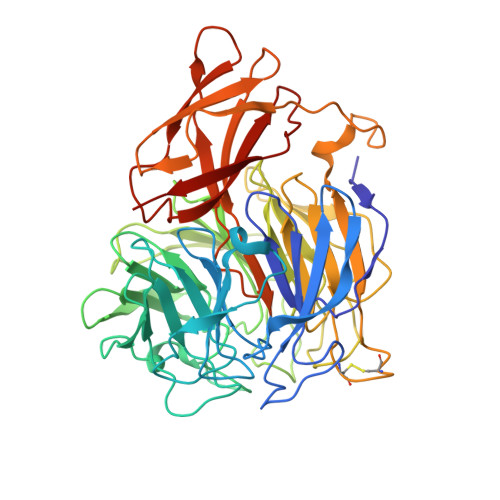Structure-function characterization reveals new catalytic diversity in the galactose oxidase and glyoxal oxidase family.
Yin, D.T., Urresti, S., Lafond, M., Johnston, E.M., Derikvand, F., Ciano, L., Berrin, J.G., Henrissat, B., Walton, P.H., Davies, G.J., Brumer, H.(2015) Nat Commun 6: 10197-10197
- PubMed: 26680532
- DOI: https://doi.org/10.1038/ncomms10197
- Primary Citation of Related Structures:
5C86, 5C92 - PubMed Abstract:
Alcohol oxidases, including carbohydrate oxidases, have a long history of research that has generated fundamental biological understanding and biotechnological applications. Despite a long history of study, the galactose 6-oxidase/glyoxal oxidase family of mononuclear copper-radical oxidases, Auxiliary Activity Family 5 (AA5), is currently represented by only very few characterized members. Here we report the recombinant production and detailed structure-function analyses of two homologues from the phytopathogenic fungi Colletotrichum graminicola and C. gloeosporioides, CgrAlcOx and CglAlcOx, respectively, to explore the wider biocatalytic potential in AA5. EPR spectroscopy and crystallographic analysis confirm a common active-site structure vis-à-vis the archetypal galactose 6-oxidase from Fusarium graminearum. Strikingly, however, CgrAlcOx and CglAlcOx are essentially incapable of oxidizing galactose and galactosides, but instead efficiently catalyse the oxidation of diverse aliphatic alcohols. The results highlight the significant potential of prospecting the evolutionary diversity of AA5 to reveal novel enzyme specificities, thereby informing both biology and applications.
- Michael Smith Laboratories and Department of Chemistry, University of British Columbia, 2185 East Mall, Vancouver, British Columbia, Canada V6T 1Z4.
Organizational Affiliation:



















